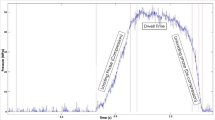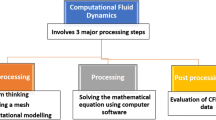Abstract
Introduction
Mini-tablets are considered a promising solid dosage form in the pharmaceutical industry due to advantages such as dosing accuracy, efficiency as a drug delivery system, and alleged improvement in mechanical properties. Nevertheless, only a few experimental studies are available in the literature regarding this topic and technical aspects, such as punch’s shape and size effect on the stress and density distribution in the compact mini-tablets, are still not fully investigated.
Objectives
In this paper, the influence of powder properties and process parameters, such as punch shape and size, on the evolution of mechanical properties during the tableting process and the potential occurrence of tablet defects are investigated using the mechanistic modeling approach, Finite Element Method (FEM).
Methods
The numerical simulation cases consist of four different die sizes, mini-tablets of 2 mm, and 3 mm, and conventionally sized tablets of 8 mm and 11.28 mm. Each tablet size is simulated using four distinctive excipients, Avicel® PH-102, Kollidon® VA64, Pearlitol® 100SD, and Supertab® 11SD, and two different punch geometries, a flat-face punch, and a bevel edge punch.
Results
The model predictions in terms of stress and density distribution at different stages of the compaction process indicate similar behavior in terms of density and stress distribution profiles between the conventionally sized tablets and mini-tablets for a particular excipient.
Conclusions
Based on tablet size, small localized differences are noted (e.g., low-density regions, high shear bands, and heterogeneous density profiles), suggesting a possible risk of tableting defects for conventionally sized tablets compared to mini-tablets. Furthermore, it is observed that bevel-edged tablets could facilitate the formation of cracks, leading to possible capping failure.







Similar content being viewed by others
References
Abaqus I. 2006. Abaqus theory manual version 6.6-1: Abaqus.
Adams MJ, McKeown R. Micromechanical analyses of the pressure-volume relationship for powders under confined uniaxial compression. Powder Technol 1996;88(2):155–163.
Ahmad J, Noor MJM, Jais MIF, Rahman ASA, Senin SF, Ibrahim A, Hadi BA. Mathematical models for stress-strain curve prediction-a. AIP Conference Proceedings vol 20005; 2020.
Aleksovski A, Dreu R, Gǎperlin M, Planiňek O. Mini-tablets: a contemporary system for oral drug delivery in targeted patient groups. Expert Opin Drug Deliv 2014;12(1):65–84. ISSN 17447593. https://doi.org/10.1517/17425247.2014.951633.
Baroutaji A , Lenihan S, Bryan K. Combination of finite element 397 method and drucker-prager cap material model for simulation of pharma398 ceutical tableting process: Kombination der finite-elemente-methode mit dem drucker-prager cap materialmodel zur simulation von pharmazeutis400 chen tablettierungsprozessen. Materialwissenschaft und Werkstofftechnik, 2017;48(11):1133–1145.
Cunningham J, LaMarche K, Zavaliangos A. Modeling of powder compaction with the drucker-prager cap model. Predictive modeling of pharmaceutical unit operations, pp 205–227. Elsevier Inc. ISBN 9780081001806. https://doi.org/10.1016/B978-0-08-100154-7.00008-9; 2017.
Denny PJ. Compaction equations: a comparison of the heckel and kawakita equations. Powder Technol 2002;127(2):162–172.
Dhondt J, Bertels J, Kumar A, Van Hauwermeiren D, Ryckaert A, Van Snick B, Klingeleers D, Vervaet C, De Beer T. 2022. A multivariate formulation and process development platform for direct compression, Vol. 623.
Eiliazadeh B, Briscoe BJ, Sheng Y, Pitt K. Investigating density distributions for tablets of different geometry during the compaction of pharmaceuticals. Part Sci Technol 2003;21(4):303–316.
Garner S, Ruiz E, Strong J, Zavaliangos A. Mechanisms of crack formation in die compacted powders during unloading and ejection: An experimental and modeling comparison between standard straight and tapered dies. Powder Technol 2014;264:114–127.
Giannis K , Schilde C, Finke JH, Kwade A. Modeling of high-density compaction of pharmaceutical tablets using multi-contact discrete element method. Pharmaceutics 2021;13(12):2194. ISSN 19994923. https://doi.org/10.3390/PHARMACEUTICS13122194.
Gou D, Li Y, An X, Yang R. DEM modelling of particle fragmentation during compaction of particles. Powder Technol 2022;398:117073. ISSN 0032-5910. https://doi.org/10.1016/J.POWTEC.2021.117073.
Han LH, Elliott JA, Bentham AC, Mills A, Amidon GE, hancock BC. A modified drucker-prager cap model for die compaction simulation of pharmaceutical powders. Int J Solids Struct 2008;45(10): 3088–3106.
Heckel RW. Density-pressure relationships in powder compaction. Trans Metall Soc AIME 1961; 221(4):671–675.
Kadiri MS, Michrafy A. The effect of punch’s shape on die compaction of pharmaceutical powders. Powder technol 2013;239:467–477.
Kawakita K, Lüdde K-H. Some considerations on powder compression equations. Powder technol 1971;4(2):61–68.
Kokott M, Lura A, Breitkreutz J , Wiedey R. Evaluation of two novel co-processed excipients for direct compression of orodispersible tablets and mini-tablets. Eur J Pharm Biopharm 2021;168:122–130.
Krok A, Peciar M, Fekete R. Numerical investigation into the influence of the punch shape on the mechanical behavior of pharmaceutical powders during compaction. Particuology 2014;16:116–131.
Krok A, Wu CY. Finite element modeling of powder compaction. Engineering crystallography: from molecule to crystal to functional form, pp 451–462. Springer; 2017.
Lura A, Tardy G, Kleinebudde P, Breitkreutz J. Tableting of mini-tablets in comparison with conventionally sized tablets: a comparison of tableting properties and tablet dimensions. Int J Pharm: X 2020;2:100061.
Mazel V, Diarra H, Tchoreloff P. Effect of friction between powder and tooling on the die-wall pressure evolution during tableting: experimental and numerical results for flat and concave punches. Int J Pharm 2019;554:116–124.
Meynard J, Amado-Becker F, Tchoreloff P, Mazel V. On the complexity of predicting tablet capping. Int J Pharm 2022;623:121949.
Pandey P, Bharadwaj R, Chen X. 2017. Modeling of drug product manufacturing processes in the pharmaceutical industry.Predictive Modeling of Pharmaceutical Unit Operations, pp 1–13. https://doi.org/10.1016/B978-0-08-100154-7.00001-6.
Partheniadis I, Terzi V, Nikolakakis I. Finite element analysis and modeling in pharmaceutical tableting. Pharmaceutics 2022;14(3):673.
Patel S, Kaushal AM, Bansal AK. 2006. Compression physics in the formulation development of tablets. Crit Rev Ther Drug Carrier Syst, vol 23(1).
Pich CH, Moest T. Magensaftresistent ü,berzogene zylindrische pankreatin-mikrotabletten. EU Patent EP 0 1989;166(315):B1.
Helwany S. 2007. Applied soil mechanics with abaqus applications.
Shang C, Sinka IC, Pan J. Constitutive model calibration for powder compaction using instrumented die testing. Exp Mech 2012;52(7):903–916.
Sinka IC, Burch SF, Tweed JH, Cunningham JC. Measurement of density variations in tablets using x-ray computed tomography. Int J Pharm 2004;271(1–2):215–224.
Sinka IC, Cunningham JC, Zavaliangos A. Analysis of tablet compaction. ii. finite element analysis of density distributions in convex tablets. J. Pharm Sci 2004;93(8):2040–2053.
Walker EE. The properties of powders. part vi. the compressibility of powders. Trans Farad Soc 1923;19(July):73–82.
Wu C-Y, Hancock BC, Mills A, Bentham AC, Best SM, Elliott JA. Numerical and experimental investigation of capping mechanisms during pharmaceutical tablet compaction. Powder Technol 2008;181 (2):121–129.
Wu C-Y, Ruddy OM, Bentham AC, Hancock BC, Best SM, Elliott JA. Modelling the mechanical behaviour of pharmaceutical powders during compaction. Powder Technol 2005;152(1-3):107–117.
Acknowledgements
Financial support for this research from the BOF (Bijzonder Onderzoeksfonds Universiteit Gent, Research Fund Ghent University) is gratefully acknowledged.
Author information
Authors and Affiliations
Corresponding author
Ethics declarations
Conflict of Interests
The authors declare that they have no conflict of interest.
Additional information
Publisher’s Note
Springer Nature remains neutral with regard to jurisdictional claims in published maps and institutional affiliations.
Rights and permissions
Springer Nature or its licensor holds exclusive rights to this article under a publishing agreement with the author(s) or other rightsholder(s); author self-archiving of the accepted manuscript version of this article is solely governed by the terms of such publishing agreement and applicable law.
About this article
Cite this article
Naranjo Gómez, L.N., De Beer, T. & Kumar, A. Finite Element Modeling of Powder Compaction: Mini-Tablets in Comparison with Conventionally Sized Tablets. Pharm Res 39, 2109–2118 (2022). https://doi.org/10.1007/s11095-022-03389-6
Received:
Accepted:
Published:
Issue Date:
DOI: https://doi.org/10.1007/s11095-022-03389-6




